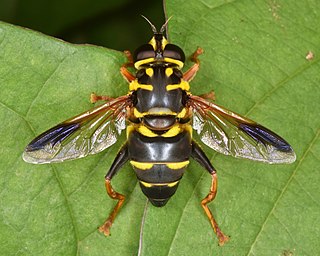
Hover flies of the genus Microdon are unusual among the Diptera. Like other members of the subfamily, they are myrmecophiles, meaning they inhabit the nests of ants.

Xylota is a Holarctic genus of hoverflies similar in structure to the related genera Chalcosyrphus and Brachypalpoides. As the larvae are saprophytic they're usually found in rotting wood. The adult flies are generally associated with woodland and woodland edges and can often be seen running over the upper sides of leaves. Unlike other syrphids the adults of many species rarely visit flowers preferring instead to gather pollen from leaf surfaces. There are over 100 described species of which 12 can be found in Europe. Seven species have been recorded in Britain. Identification of species has been difficult and identifiction by photographs is risky.

Spilomyia is a genus of hoverflies. Many species in the genus show Batesian mimicry of wasp models, including black and yellow patterns and modified antenna shape.

Dasysyrphus is a genus of hover flies with 50 identified species distributed worldwide. While the genus is relatively easy to identify, genera key the differences between species have a more narrow range of variations. Therefore, identification of species by images of specimens alone should be made with care.

Platycheirus is a large genus of hoverflies. They are also called sedgesitters.

Chalcosyrphus is a genus of hoverflies in the subfamily Eristalinae. Many species exhibit some degree of mimicry of various sawflies and other hymenopterans and are often brightly coloured or metallic in hue. The adults are similar in structure and behavior to the related genus Xylota but differ in larval morphology. They can be found throughout Europe, Asia, and North America and seem to prefer damper, boggy habitats. The larvae are saproxylic feeders in rotten wood in these habitats.

These are small black and yellow or mostly black flies with a narrow abdomen near the thorax. They occur mainly in damp places among low herbage. The larva of Neosascia are flattened without oral hooks and a have a short posterior spiracular process or "tail" rat-tailed that is saprophagous. In 1925 Curran reviewed the genus Neoascia. In this work a key is provided and ten species are described including four new species some of which have later been determined to be synonyms.

Trichopsomyia is a genus of Hoverflies, from the family Syrphidae, in the order Diptera.
Chymophila is a subgenus of the hoverfly genus Microdon. It was previously considered to be exclusively Neotropical, but is now also known from the Nearctic and Oriental realms, and one species is known from Japan. Chymophila was based on a composite type species: the holotype is a body of C. fulgens with the head of a conopid glued on.
Mixogaster is a genus of hoverflies native to North America and South America, with 21 known species. Mixogaster is distinct by lacking an appendix on vein R4+5, having a reduced and bare metasternum, an unarmed scutellum, and usually an appendix on vein M extending in cell R4+5. Larvae are found in ant nests.

Ornidia is a small genus of small (2.3–4.2 mm) metallic hoverflies.
Pseudomicrodon is a genus of hoverflies, with 14 known species. All are species with petiolate abdomens.

Monoceromyia is a genus of hoverfly. Species in the genus are found in the Afrotropical, Australasian, Neotropical and Oriental regions. They are mimics of wasps and the genus is distinguished by the metapleura being widely separate behind the hind coxae. The elongated frontal base of the antenna is at least as long as the basal segment of the antenna and the second abdominal tergum is longer than wide and constricted.

Ocyptamus is a large and diverse genus of over 200 species of hoverfly mostly found in the Neotropical region. It is likely that many of these species will be discovered to be synonyms though many others await description.

Palpada is a genus of 85 neotropical and nearctic flower flies or hoverflies This genus is often colorful and bee-like. It is in the tribe Eristaliini containing dozens of genera Common sister genera include Eristalis (99 species), Meromacrus (43 sp.), Eristalinus (100 sp.) and Helophilus (50 sp.). The genus palpada is distinguished by:

Meromacrus is a genus of 43 neotropical and nearctic flower flies or hoverflies
Sterphus is a genus of hoverflies.
Total of 245 species either found or highly expected to be found in New York.












